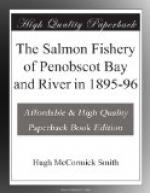| Date | Date of | Date of | Total | Aggre- | Avg | | when ice | catching| catching | number | gate | weight | | ice left | first | largest no. | of |weight of| of | Year | river | salmon | of salmon | salmon | salmon | salmon | ------------------------------------------------------------
--------| 1874 | Apr. 20 | Apr. 30 | June 10 | 86 | 1,253 | 14.57 | 1875 | Apr. 18 | May 13 | June 15 | 70 | 908 | 12.97 | 1876 | Apr. 14 | Apr. 25 | June 17 | 68 | 1,027 | 15.10 | 1877 | Mar. 30 | Apr. 24 | June 9 | 72 | 1,002 | 13.92 | 1878 | Apr. 4 | Apr. 21 | June 26 | 151 | 2,052 | 13.52 | 1879 | Apr. 25 | May 12 | June 20 | 147 | 1,756 | 11.95 | 1880 | Apr. 9 | May 7 | May 31 | 86 | 1,111 | 12.92 | 1881 | Mar. 21 | Apr. 17 | June 9 | 85 | 1,480 | 17.41 | 1882 | Apr. 10 | May 1 | May 29 | 154 | 1,711 | 11.11 | 1883 | Apr. 13 | do | June 12 | 98 | 1,643 | 16.77 | 1884 | Apr. 9 | Apr. 29 | June 28 | 95 | 911 | 9.59 | 1885 | Apr. 19 | May 8 | June 4 | 91 | 1,104 | 12.13 | 1886 | Apr. 16 | Apr. 21 | June 2 | 100 | 1,631 | 16.31 | 1887 | Apr. 23 | May 8 | June 25 | 150 | 2.020 | 13.47 | 1888 | Apr. 15 | Apr. 29 | June 9 | 159 | 2,196 | 13.81 | 1889 | Apr. 2 | Apr. 21 | June 6 | 85 | 1,246 | 14.66 | 1890 | Apr. 7 | Apr. 20 | May 30 | 41 | 641 | 15.63 | 1891 | Apr. 2 | Apr. 28 | June 9 & 16| 117 | 1,199 | 10.25 | 1892 | do | Apr. 9 | June 5 | 65 | 989 | 15.22 | 1893 | Apr. 15 | Apr. 23 | June 10 | 102 | 1,384 | 13.57 | 1894 | Apr. 12 | Apr. 19 | June 1 & 3 | 88 | 1,160 | 13.19 | 1895 | Apr. 6 | Apr. 21 | June 3 | 75 | 1,191 | 15.88 | 1896 | Apr. 12 | Apr. 16 | June 6 | 192 | 2,524 | 13.15 |
Note.—The weirs are set
one or two days after the ice moves
out. Occasionally they are
put in place before the ice leaves.
Apparatus and methods of the fishery.
There is probably no other river in the United States in which a fishery of such magnitude has undergone so few changes with respect to methods, number of traps operated, and sites where nets are set, as the Penobscot. This is chiefly owing (1) to the character of the bottom, (2) to the fact that the fishing is a riparian privilege enjoyed only by those who own land fronting on the water, (3) to the circumstance that the fishing is almost entirely of a semi-professional character, and has been taken up by generation after generation as a part of the regular duties connected with the small farms, and (4) to the small number of food-fishes occurring in the river, and the preponderating importance of two of them—the salmon and the alewife—for which the nets are exclusively set.




